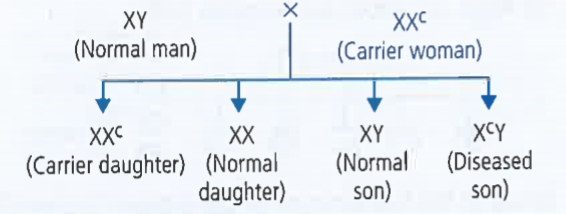Which of the following traits helps in wind dispersal
Barbs and hooks
Hair and wings
Sticky glands
Round and compact seeds
The correct Answer is:B
Step-by-Step Solution:
1. Understanding the Question: The question asks which trait helps in wind dispersal of seeds. We need to analyze the given options to determine which one is suitable for this method of seed dispersal.
2. Analyzing the Options:
- Option A: Bars and Hooks: These traits are typically found in seeds that attach to animals for dispersal, not for wind dispersal.
- Option B: Hair and Wings: Seeds with hair-like or wing-like structures are designed to be lightweight and can stay airborne longer, making them ideal for wind dispersal.
- Option C: Sticky Glands: These are adaptations for seed dispersal by animals, as they help seeds stick to the fur or skin of animals.
- Option D: Round and Compact Seeds: These seeds are generally heavier and not suited for wind dispersal, as they lack the features necessary to be carried by the wind.
3. Identifying the Correct Answer: Based on the analysis, the correct answer is Option B: Hair and Wings, as these traits are specifically adapted for wind dispersal.
4. Conclusion: The seeds that have hair-like or wing-like structures are lightweight and can be carried by the wind, making them suitable for dispersal through this method.
- Option A: Bars and Hooks: These traits are typically found in seeds that attach to animals for dispersal, not for wind dispersal.
- Option B: Hair and Wings: Seeds with hair-like or wing-like structures are designed to be lightweight and can stay airborne longer, making them ideal for wind dispersal.
- Option C: Sticky Glands: These are adaptations for seed dispersal by animals, as they help seeds stick to the fur or skin of animals.
- Option D: Round and Compact Seeds: These seeds are generally heavier and not suited for wind dispersal, as they lack the features necessary to be carried by the wind.
Topper's Solved these Questions
- FRUIT AND SEED DISPERSAL BOOK - DINESH PUBLICATION ENGLISHCHAPTER - FRUIT AND SEED DISPERSAL EXERCISE - CHECK YOUR GRASP
10 Videos
- FLOWERBOOK - DINESH PUBLICATION ENGLISHCHAPTER - FLOWEREXERCISE - MULTIPLE CHOICE
258 Videos
- GENETIC BASIS OF INHERITANCEBOOK - DINESH PUBLICATION ENGLISHCHAPTER - GENETIC BASIS OF INHERITANCEEXERCISE - Check your Grasp
30 Videos
Similar Questions
Knowledge Check
Which of the following traits reflects personality development?
AHelpfulnessBTeam spiritCBoth (a) and (b)DNone of themWhich of the following constitutes the wind pipe, or the upper four inches of the airway?
ATracheaBPharynxCLarynxDBronchiInheritance of which of the following traits is shown in the given cross ?
 AX-linked dominant traitBX-linked recessive traitCautosomal recessive traitDAutosomal dominant trait
AX-linked dominant traitBX-linked recessive traitCautosomal recessive traitDAutosomal dominant trait
Which of the following helps in ascent of sap?
View SolutionWhich of the following helps in ascent of sap?
View SolutionHooks help in fruit dispersal of
View SolutionWhich of the following trait of garden pea is present on 7th chromosome ?
View SolutionWhich of the following traits is not characteristics of echinoderms ?
View Solution
